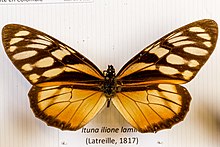Lycorea ilione
Lycorea ilione, the clearwing mimic queen is a species of nymphalid butterfly in the subfamily Danainae. The species was first described by Pieter Cramer in 1775.[2]
| Lycorea ilione | |
|---|---|
| Lycorea ilione phenarete | |
| Scientific classification | |
| Kingdom: | Animalia |
| Phylum: | Arthropoda |
| Class: | Insecta |
| Order: | Lepidoptera |
| Family: | Nymphalidae |
| Genus: | Lycorea |
| Species: | L. ilione |
| Binomial name | |
| Lycorea ilione Cramer, 1775 | |
| Synonyms[1] | |
| |
Subspecies
Subspecies include:[2]
- Lycorea ilione ilione; present in Brazil
- Lycorea ilione albescens (Distant, 1876); present in Central America
- Lycorea ilione decolorata (Haensch, 1909); present in Ecuador
- Lycorea ilione lamira (Latreille, [1817]); present in Colombia
- Lycorea ilione phenarete (Doubleday, 1847); present in Bolivia and Peru
Distribution and habitat
This species is present in Mexico, Guatemala, Colombia, Ecuador, Brazil, Bolivia and Peru.[2] It occurs in the transitional rainforest and cloudforest, at an elevation of 500–1,500 metres (1,600–4,900 ft) above sea level.[3]
Description

Lycorea ilione can reach a wingspan of about 10 cm (3.9 in). It is an extremely variable species. These large and strongly marked butterflies show yellow-tipped antennae and black thorax with white dots and gray abdomen. All wings are rounded, with forewings much longer than the hindwings and with concave inner edge. The wings are transparent, bordered with black, with black veins and dark bands dividing the wings into several areas. Some subspecies are brown with brown basal part of the forewings.
Biology
The larvae mainly feed on Ficus species (F. benjamina, F. carica and F. pumila), but also on Jacaratia hasslerina, Carica papaya and Myoporum lactum.[2] Males feed on Senecio, Eupatorium and Neomiranda flowers from which they obtain alkaloids used for chemical defense, as these toxins cause nausea in birds that prey them.[3]
References
| Wikimedia Commons has media related to Lycorea ilione. |
- "Danaini". Nymphalidae.net. Archived October 4, 2011.
- Savela, Markku (April 18, 2015). "Lycorea ilione (Cramer, [1775])". Lepidoptera and Some Other Life Forms. Retrieved July 5, 2020.
- "Clearwing-mimic Queen". Butterflies of the Amazon and Andes. Learn About Butterflies. Retrieved July 5, 2020.
External links
- "Inventory of the butterfly species of Sangay National Park - Ecuador".
- "Species Lycorea ilione". Butterflies of America.